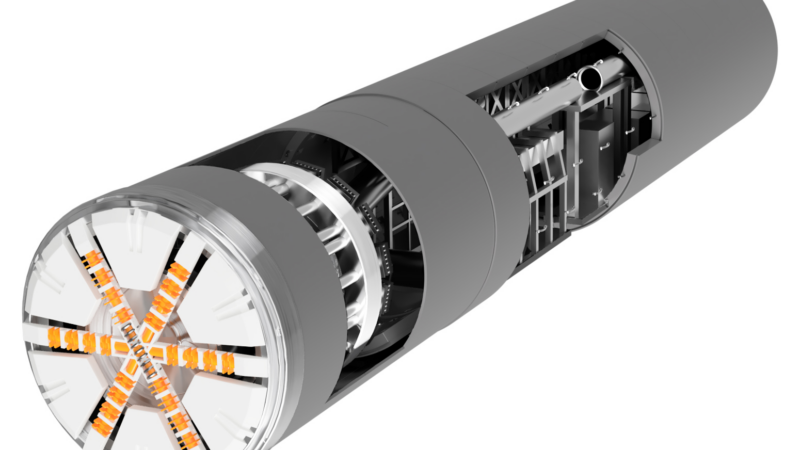Relining of monolithically lined casting ladles in steel plants: Precise control instead of uncontrolled wrecking
The new vertical ladle milling unit MLC 2011, developed by SIMPEX HYDRAULIK, simplifies the relining of monolithically lined casting ladles, while cutting refractory and waste disposal costs. The automatic process reduces personnel requirements to a minimum.
The mobile vertical ladle milling unit MLC 2011 contains a precisely controllable milling head for the removal of fused refractory material and baked-on slag from the existing monolithic lining on the inside wall of the casting ladle. This is an optimal preparation for the application of the new layer of refractory material.
Before the ladle can be relined, the inside wall must be „white“ in order for the new refractory concrete to properly bond with the remaining refractory layer. This means that there must not be any fused areas or areas with baked-on slag left. At the same time, it is to be avoided that any material still in good condition will be removed.
The new ladle milling unit operates with a precisely controllable milling head. The thickness of the layer to be removed is set according to the degree of fusion. While ladle wrecking by means of manually operated wrecking machines or caterpillars with hydraulic hammers is extremely difficult to control, the new machine removes the worn refractory layer in a perfectly controlled and uniform way.
The entire process takes place automatically. This dramatically reduces the time requirement compared to the previously common manual practice. The operation takes approximately one hour. When the milling has been completed, the inside walls are visually inspected. If necessary, another layer is removed or certain areas are specifically reworked with the milling head operated manually. The system is also suitable for spot repairs in cases where it is not necessary to mill the complete inside wall of the ladle.
The amount of wrecked material is dramatically reduced because the system does not remove more material than necessary. This cuts not only the transportation and disposal costs for the waste material, but also the consumption of refractory concrete. As the material consists of aluminium oxide (AI2O3), it may for example be used as slag forming agents, resulting in a closed and thus eco-friendly system.
Additionally, the ladle milling unit extends the life of the permanent lining. As the ladle is in the upright position during milling, it sits solidly in the ladle cone. Therefore it is subjected only to pressure load. Moreover, there are no impact effects acting on the monolithic or the permanent lining, as would occur during manual wrecking with the ladle in a tilted position. Thus, the ladle milling unit avoids the occurrence of cracks and brittleness.
SIMPEX HYDRAULIK has developed the ladle milling unit in cooperation with Hackenberg Ingenieurgesellschaft. The design phase has been completed. The first prototype will be built shortly.
According to Andreas Berendt, Managing Director of SIMPEX HYDRAULIK GmbH, the system will provide numerous benefits: „The milling unit saves not only material and disposal costs. It also eliminates a great deal of the strenuous and hazardous work taking place in a steel plant.“
The first unit has been designed for casting ladles with filling weights between 80 and 160 t. It consists of the milling equipment proper, a holding frame and a container, which accommodates the hydraulic unit including the tank and the controls.
The equipment is easy to use: A bay crane, which is typically available in any steel plant, lifts the milling unit into the ladle. Three hydraulic cylinders ensure that the unit is perfectly centred and fixed inside the ladle. Here a key advantage of this milling unit becomes obvious: The milling head is always accurately positioned relative to the ladle and it can be moved to any position of the lining – either automatically or manually by remote control.
Milling is performed automatically. It takes approximately one hour to be completed. Afterwards, the milling unit will be lifted into the provided holding frame or into the next ladle to be milled.
About SIMPEX HYDRAULIK
SIMPEX HYDRAULIK has a more than 35-year track record of brand- and manufacturer-independent expertise and quality in the fields of hydraulics, pneumatics and centralised lubrication technology. Having emerged from the trade in hydraulic components, today the company is engaged in the development, manufacturing and commissioning of hydraulic plants and plant units, test stands and components for sensor and servo-technology.
In the field of centralised lubrication technology, the company’s activities in revamps of existing plants and in the construction of new plants are as much sought-after as its maintenance services.
Another core competency of this group of medium-sized companies is the repair and overhaul of hydraulic components of all kinds, independent of brands and manufacturers.
The enterprises SIMPEX HYDRAULIK GmbH in Brandenburg, Eisenhüttenstadt, Gera and Neuss (all Germany) are companies of HYDRAULIK UNION.
Firmenkontakt
SIMPEX HYDRAULIK
Andreas Berendt
Siemensstraße 39
07546 Gera
+49.365.438415
+49.365.438417
andreas.berendt@simpex-hydraulik.de
www.simpex-hydraulik.de
Pressekontakt
VIP-Kommunikation
Regina Reinhardt
Süsterfeldstraße 83
52072 Aachen
+49.241.89468-24
reinhardt@vip-kommunikation.de
www.vip-kommunikation.de






